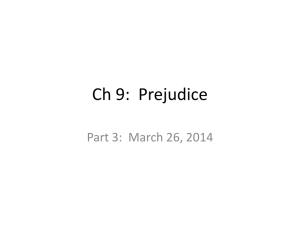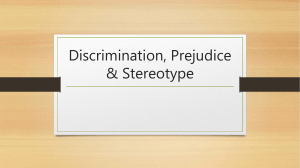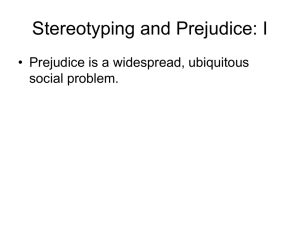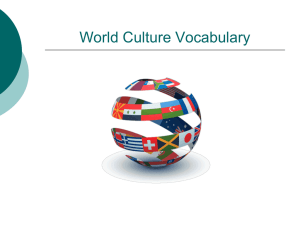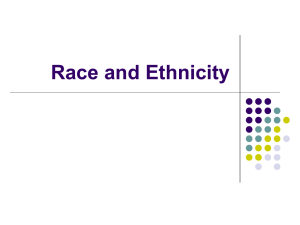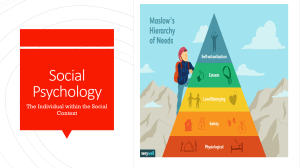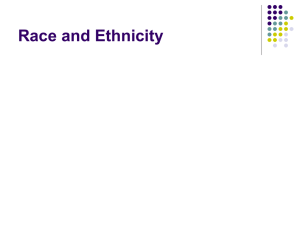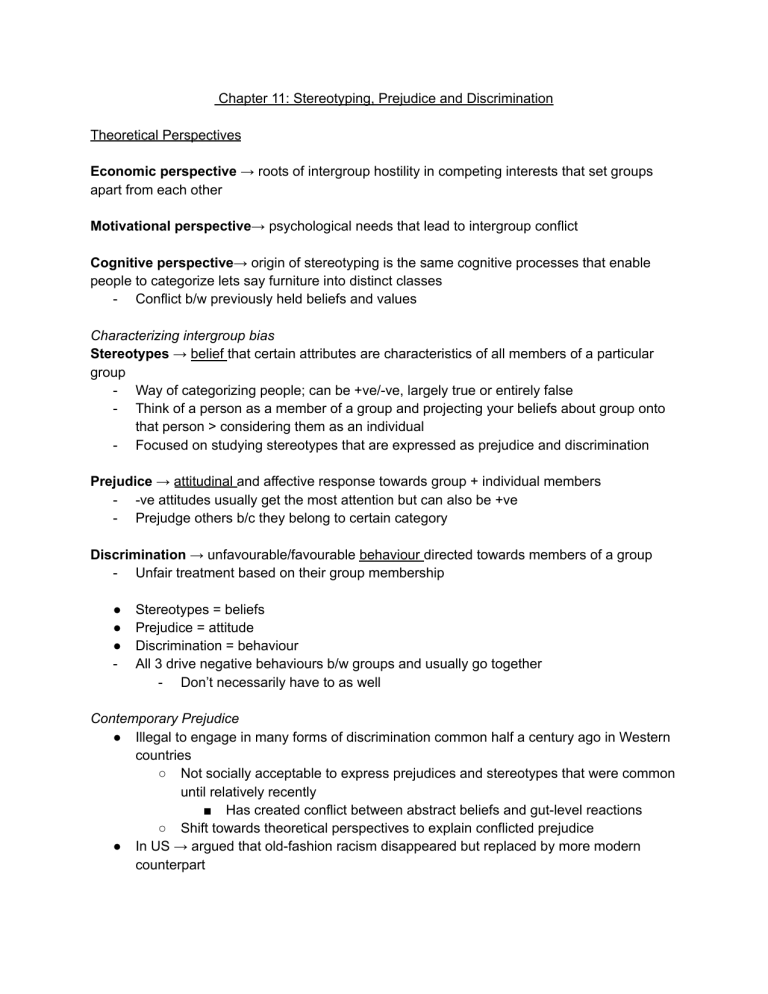
Chapter 11: Stereotyping, Prejudice and Discrimination Theoretical Perspectives Economic perspective → roots of intergroup hostility in competing interests that set groups apart from each other Motivational perspective→ psychological needs that lead to intergroup conflict Cognitive perspective→ origin of stereotyping is the same cognitive processes that enable people to categorize lets say furniture into distinct classes - Conflict b/w previously held beliefs and values Characterizing intergroup bias Stereotypes → belief that certain attributes are characteristics of all members of a particular group - Way of categorizing people; can be +ve/-ve, largely true or entirely false - Think of a person as a member of a group and projecting your beliefs about group onto that person > considering them as an individual - Focused on studying stereotypes that are expressed as prejudice and discrimination Prejudice → attitudinal and affective response towards group + individual members - -ve attitudes usually get the most attention but can also be +ve - Prejudge others b/c they belong to certain category Discrimination → unfavourable/favourable behaviour directed towards members of a group - Unfair treatment based on their group membership ● ● ● - Stereotypes = beliefs Prejudice = attitude Discrimination = behaviour All 3 drive negative behaviours b/w groups and usually go together - Don’t necessarily have to as well Contemporary Prejudice ● Illegal to engage in many forms of discrimination common half a century ago in Western countries ○ Not socially acceptable to express prejudices and stereotypes that were common until relatively recently ■ Has created conflict between abstract beliefs and gut-level reactions ○ Shift towards theoretical perspectives to explain conflicted prejudice ● In US → argued that old-fashion racism disappeared but replaced by more modern counterpart Modern racism → subtle prejudice directed at racial groups that exist alongside rejection of explicitly racist beliefs - Reject explicitly racist beliefs but still feel animosity and discomfort being around them - Often strong egalitarian (equal) values → reject prejudice and discrimination but also have unacknowledged -ve feelings and attitudes toward minority groups - Stem from ingroup favoritism and desire to defend status quo - From ingroup favouritism + desire to defend status quo - If prejudice is rationalizable and justifiable → prejudice will emerge - Experiment 1: - White participants could help a white/black person in need of medical assistance - If thought they were the only aid: - More likely to help black person more often than white person - When thought other people were present and could be justified on non-racial grounds: - Much less likely to help black person than white person - Masked.subtle prejudice/discrimination - Experiment 2 - White participants evaluated black and white applicants to college - Either low/high in explicit prejudice - When both b/w participants excelled/really bad on relevant dimensions = rated same - When they had mixed dimensions → black applicants rated less favourably > unprejudiced - Prejudiced could defend responses as nondiscriminatory ‘Benevolent’ racism and sexism ● Many of our ‘isms’ can be ambivalent → containing both positive and negative features ● Benevolent sexism usually coexists with hostile sexism Benevolent sexism→ ideology marked by protectiveness and affection towards women who embrace conventional roles Hostile sexism → dislike of nontraditional women and those viewed as usurping men’s power ● ● ● Ambivalent and benevolent = particularly resistant to change ○ Favourable features of beliefs enable stereotype holders to deny any prejudice Benevolent and hostile inhibit progress towards equality ○ Ambivalent attitudes → tend to act positively towards members of outgroup only if members fulfill idealized image of what they should be ■ When women deviate from outgroup stereotype → tend to be treated with hostility Benevolent can also be as damaging as hostile sexism Measuring attitudes about groups ● ● Measured through surveys of adjectives that they believe characterize members of different groups ○ Also self-report questionnaires asking about attitudes and beliefs about members of different groups Surveys usually can’t always be trusted b/c might not think it’s acceptable to express true feelings ○ Self report not always acceptable b/c may be unconscious, hidden thoughts and behaviours as well Implicit attitudes are measured through: Implicit association test (IAT) → reveal subtle, nonconscious prejudices - Words presented on screen → press a key if picture/word conforms to one rule - Press another key if it conforms to another rule - Response test; likely to be faster to press one key for members of a certain group and same key for members of a different group > if they were different keys - Assess implicit prejudice through speed - Repeat task with pairings of groups and words switched - Ex: nonconscious prejudice → difference b/w responding to old faces/positive words and average time of old faces/negative words - Prejudiced would take longer to respond to old faces/positive words - Results of IAT usually show preference for young > old and white > black - Correlated with amygdala in response to black faces Priming → mental activation procedures to measure prejudice that might not know they have / wish to deny - Show participants a word → a related string of letters that was related is recognized faster > unrelated string - If associate ‘nun’ as good, more likely to respond to positive terms - If you have -ve associations to nuns, likely to respond more quickly to negative terms - Another kind of response time test → shouldn’t assume they are lying when they deny prejudices; might just be unconscious beliefs Affect misattribution procedure (AMP) - alternative to priming procedure - How quickly people EVALUATE stimulus (priming was how quickly people respond) - Shown picture of a particular group member → followed by neutral/unfamiliar image - Do the feelings associated with the target group transfer to neutral image? - If -ve evaluation to group ember → average rating of neutral image would be lower than average rating that follows non-group member photo Economic Perspective ● Tension b/w groups that vie for same limited resources ○ Groups develop prejudices about each other and discriminate against each other when competing for material resources Realistic group conflict theory → group conflict, prejudice and discrimination are likely to arise over competition b/w groups for limited resources - Prejudice and discrimination increase economic difficulty (ex: recessions and high period of unemployment) - Strongest towards groups that stand to lose the most from another group’s economic advantage - Also compete for ideology and cultural supremacy (whose god should be worshiped, what should be allowed to be on the internet) - Group conflict plays out through ethnocentrism → glorifying one’s own groups while vilifying other groups - People that are outgroups become stereotyped; loyalty to ingroup intensifies Robbers Cave Experiment ● ethnocentrism from intergroup competition ● Phase 1 → independent activities within groups to foster group unity ○ Developed cohesion between each group (eagles and Rattlers) ● Phase 2 → members of winning team get a medal and pocketknife ○ Competitive nature of tournament was designed to encourage group to see the other group as an obstacle and enemy to winning ■ Insults and trash talked each other ● Phase 3 → reducing conflict b/w 2 groups ○ Noncompetitive settings did NOT dissipate hostility ○ Confronted boys with crises that needed to be resolved together ■ Superordinate goals→ goal that transcends interests of any one group; can be achieved more readily by 2+ groups working together ○ Name calling dropped, wanted to return on the same bus and the team that won at the event decided to buy drinks for everyone ● Lessons: ● Differences in background or history of conflict are not necessarily for intergroup hostility ○ All that is required is 2 groups enter into competition against others for rewards that only one can attain ● Competition against outsiders usually increases group cohesion ● To reduce hostility, think of ways to get them to work together Jigsaw Classroom ● Divide material on a topic and each student has to master each part and teach it to the others ○ Ensures no student could learn entire lesson w/o help from peers ■ Everyone’s material fit together like a ijg saw for everyone to learn the whole lesson ○ Encourages cooperation towards common goal ○ Tend to like school more and develop more positive attitudes toward different ethnic groups > traditional classrooms ■ Intergroup hostility can be diminished by cooperation towards superordinate goals Motivational perspective ● Hostility can develop merely because another group exists ○ Existence of group boundaries can be sufficient to initiate group discrimination Minimal group paradigm → experiment paradigm where researchers created groups based on arbitrary and seemingly meaningless criteria; then examine how members of these ‘minimal groups’ are inclined to behave towards one another - Had to estimate # of dots on a screen → grouped into underestimate vs overestimators - Actually randomly assigned - Truly did not know how who the other members were - Had to award points for members of the in group and outgroup redeemable for money - ONLY knew group membership - Majority of participants want to maximize relative gain for members of ingroup > outgroup than maximizing absolute gain for their in group - Still tend to favor their minimal ingroup ● Minimal group paradigm establishes how this division occurs (us vs them) ○ Social identity theory used to explain what motivates us to treat ingroup better than outgroup Social identity theory → idea that a person’s self concept and self esteem derive not only from personal identity and accomplishments but also from status and accomplishments of various groups that person belongs to - Like to boost the status of the groups that we belong to → do what we can to feel better about ingroup ultimately makes us feel better about ourselves - Displayed ingroup favouritism = higher SE than those that didn’t have chance to boost own group at expense of another - Stronger pride in group affiliations = more prone to in-group favouritism - React to criticism of group as if it were criticism of the self - Basking in reflected glory → take pride in accomplishments of other people in one’s group (sporting fans identify w/ winning team) - More likely ot wear school merch after victory > defeat - First person when victory, third person when loss - Criticizing another group makes people feel better about their in group and thus themselves - Threatened / did NOT threaten SE and made it known that they were / were not jewish - If SE was threatened (received -ve feedback) → rated candidate more negatively if they thought she was Jewish (denigrated member) - Experienced increase in their SE after denigrating members of outgroups - - - Not threatened SE did NOT Another experiment: hypothesized those criticized by black doctor would think of him more as a black man > doctor and vise versa if they were praised - If criticized → were faster at recognizing words associated w/ black stereotype - Faster at recognizing medical words when praised by black doctor Individuals will also denigrate out-group members when their groups are under threat - Ex: when white ppl are made aware of changing racial demographics of their country → express more negative attitudes toward minority groups The Cognitive Perspective ● Stereotyping is inevitable → stems from categorization ○ Categorizing allows us to process what’s surrounding us Stereotypes and Conservation of Cognitive Resources ● Stereotypes are useful schemas that allow for efficient information processing ○ More inclined to use them when we’re overloaded, tired or mentally taxed (need a shortcut) ● More likely to invoke stereotypes when: ○ Tested at low point of circadian rhythm (ex: for morning people, more likely to evoke stereotypes at night and vice versa) ■ Also more likely to stereotype when intoxicated with alcohol ● Using stereotypes frees up cognitive resources that can be applied to other mental tasks ○ Tested in an experiment → performed 2 tasks simultaneously ■ Formed an impression of a hypothetical person described by traits on a computer screen ■ Other task = monitored tape-recorded lecture and take a quiz ● For some participants questions, terms also had a stereotype ○ Found that use of stereotypes made first task easier → freed up cognitive resources that allowed them to perform better on the second task ■ Given stereotype → remembered relevant info better and also performed better on test Construal Processes and Biased Assessments ● Have stereotypes and judgments ○ Ex: if see hannah as an upper middle class → see her ambiguous performance as actually better than average ■ Vice versa for working class → assumed would perform worse Illusory correlation → people sometimes see correlations (relationships) between events, characteristics or categories that are not actually related - Might be how we process unusual/distinctive events → distinctive = captures attention - More likely to remember them better - Minority groups are by definition distinctive and stand out - Negative behaviours also stand out - - Therefore negative behaviours by minority group members are doubly distinctive and doubly memorable Minority are vulnerable to being stereotyped → more likely to engage in -ve behaviour Paired distinctiveness → pairing of 2 distinctive events that stand out even more b/c they occur together - Group A / B → 2/3 of the actions they read described group a (became majority) - Overestimated how often the negative behaviours were performed by the minority group - Also rated minority less favourably - Left experiment thinking smaller group did more bad things - Distinctive-based illusory correlations → detect false correlations based on distinctiveness of minority + negative behaviours ● ● ● Beliefs in illusory correlations can be formed on basis of a single instance of unusual behaviours by a minority group Stereotypes influence how details of an event are interpreted ○ Pushing experiment → race made a difference in how the action was interpreted ■ Appeared to be perpetuated by a black man = coded as more serious Influence of stereotypes can be even stronger when episode is presented to people secondhand → more open to being construed in different ways ○ Information consistent with a group stereotype usually has more impact than information that is inconsistent with it - Stereotypes can be reinforced by self-fulfilling prophecies → people act towards members of certain groups in ways that encourage behaviour they expect to see from them ● ● People evaluate disconfirming evidence to reduce its impact Subtyping → explaining away exceptions to a given stereotype by creating a subcategory of the stereotyped group that can be expected to differ from the group as a whole ○ Seen as just the exception of the rule ○ People treat evidence that supports a stereotype differently from evidence that refutes it ■ Tend to accept supportive info at face value; critically analyze and discount contradictory evidence Often attribute consistent behaviour with stereotype to the dispositions of people involved ○ Behaviour inconsistent with a stereotype are attributed to external causes ■ Ex: if have -ve perception of jews, if they are good they attribute that to external causes and not their actual character Supportive and contradictory info is also treated differently by how abstractly we evaluate the actions ○ More concrete (ex: lifted the fallen man) = says less about person involved ● ● ● ● ● ● ○ More abstract description (ex: Altruistic) = more says about the person In horse racing experiment: ○ Participants maintained +ve views of own group by describing -ve actions of members of their own group in more concrete terms (low abstraction) ■ Individual was less implicated in the action ○ Maintained -ve views of other group by describing -ve actions of members of other group at high abstraction ○ For +ve actions, described it at low abstraction for other group Idea of perceiving ingroup favourably ○ Abstractly evaluating events that FIT stereotype leads to greater import Concretely evaluating events that violate preferences → makes them less consequential Abstract = to describe stereotype consistent actions overall (desirable by ingroup, undesirable by outgroups) Accentuation of ingroup similarity and outgroup difference ● We usually consistently consume our beliefs are more similar to members of an in group > an out-group membership even when it was arbitrary ○ Make this assumption even when groups are random or a dimension like body weight or age that does not affect attitudes or behaviours Outgroup homogeneity effect → tendency for people to assume that within-group similarity is much stronger for outgroups than for ingroups - ‘They’ are more similar and homogeneous > us - Occurs b/c we have more contact w/ members of our own ingroup > outgroup - Encounter evidence of divergent opinions and habits (higher frequency) - Also different nature of interactions w/ ingroup and outgroup: - Don’t treat ingroup member as representative of a group → see them as individual - Outgroup member → see them as representative; their unique characteristics are not as evident - Own-race identification bias → the tendency for people to be better able to recognize and distinguish faces from their own race than from other races - People interact w/ those from own race as individuals w/o thinking about race - Individual features processed more deeply - Outgroups → more attention devoted to race Automatic and Controlled Processing ● Subtyping → conscious process ● Illusory correlations and outgroup homogeneity effect → automatic ○ Stereotypes and prejudice as well ● What separates prejudice vs nonprejudiced people is if they choose to resist stereotypes ○ Activation of stereotypes are automatic ■ Non-prejudiced person will try to use more controlled cognitive processes to discard or suppress stereotypes ○ ● In experiment, found that when they primed them with -ve stereotype of african-american, still rated character as more hostile → effect for both prejudiced and non-prejudiced ■ Shows that it’s an active action to suppress stereotypical info In the video game experiment ○ Black targets → more likely to make mistake of shooting if unarmed than failing to shoot if the target was armed ■ More pronounced effect when background itself is threatening + when black africans have more stereotypical features ○ Reaction times continue even if tendency to shoot diminishes Being a member of a stigmatized group - Three burdens that come with knowing others might be prejudiced against their group Attributional Ambiguity Attributional ambiguity → not knowing underlying causes of what they experience ● Can’t always tell if their experiences have the same causes as majority OR if are being treated a different way as a result of prejudice ○ Ex: would I have experienced the same thing if I was white? ○ Is an accomplishment b/c of affirmative action policy (ex: diversity hire)? ● Experiment: half participants were seen half weren’t → half black half white ○ Being seen/not didn’t affect white p ○ Black students → when thought they were seen, -ve feedback had -ve impact on SE and increased with positive feedback ○ When thought other person could se them → SE NOT injured by bad news ■ Wasn’t enhanced either for good news ● Overall live in a ‘less certain’ world → not sure what cause to attribute experience to Stereotype Threat Stereotype threat → fear of confirming the stereotypes that others have about one’s group - Can impair performance; end up conforming to it - Experiment: - Effect on women’s math test scores and idea that women don’t perform as well as men in mathematics - Either told was/was not gender difference - Equal performance when no perceived gender difference; women performed worse than men when they thought there was a gender difference - Even being in the presence of 2 men instead of 2 women decreased scores - Even indicating your race and believing that it was a measur eof intellectual ability would impede it - Ex: stereotype that asians are better at math - When reminded of this, white males did worse - Ex: for asian american women → did worse when gender was highlighted, better when race was highlighted ● ● Overall, stereotype threat leads to increased arousal → can interfere w/ performance on complex tasks and be distraction with concentrating ○ Can also elicit more -ve thinking and lead individuals to ‘play it safe’ and be more obsessed with not failing > striving for success Vulnerability of African Americans has particular potential for damage ○ Can result in poorer overall academic performance → undermines confidence ■ Makes individual more susceptible to stereotype threat Cost of Concealment ● Stigmatized groups feeling compelled to hide their true identity (ex: LGBTQ remaining in the closet) ● Physical concealment of sexual orientation associated with -ves like ○ Cardiovascular stress, rapid progression of HIV ■ Being out of the closet as associated with better mental health ● Concealment is mentally taxing → less able to perform well on subsequent tasks Reducing Stereotypes, Prejudice and Discrimination ● Increased daily interactions b/w members of different groups = easier to see them as individuals > representative of particular groups Individual Approaches to Prejudice Reduction ● Lab studies aimed at convincing people that norms favouring outgroup tolerance are effective in reducing stigmatized groups ○ Idea of promoting greater acceptance of outgroups ● British schoolchildren randomly assigned to listen to and discuss stories about friendships b/w disabled and non disabled ○ Children later expressed greater willingness to interact with them ■ Idea of reading about it and furthering knowledge Intergroup Approaches to Prejudice Reduction Contact hypothesis → preposition that prejudice can be reduced by putting members of majority and minority in frequent contact with one another - BUT cannot just put them in contact to reduce animosity (illustrated in Robbers Cave study) - Contact is likely to be more positive if: - a) Groups have equal status - b) productive intergroup interactions can occur if groups have shared goal requiring mutual cooperation (superordinate goal) - c) community support (their broader social norms must support intergroup contact through parents, teachers, community, etc) - d) encourage 1 on 1 interactions b/w members of different groups → seen as individual - Illustrated in sports teams, war, etc. Dimensions of productive intergroup contact ● Three important changes happen that reduce prejudice with groups that had previous conflict: ○ 1. Start to see members of outgroup as individuals > stereotyped, undifferentiated #s of social category → process of personalization ■ Easier to empathize and think of them as similar to themselves ○ 2. Positive feelings of outgroup member starts to generalize to outgroup as a whole ■ Outgroup members you interact with are seen as typical (no longer subtyped) ○ 3. Positive group sentiments are solidified when members of both groups think of themselves as sharing a common identity ■ Ex: white/black teammates → just thought of as teammates
